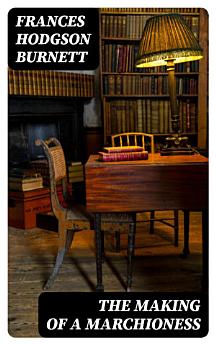The Making of a Marchioness
ឧសភា 2022 · DigiCat
សៀវភៅអេឡិចត្រូនិច
100
ទំព័រ
family_home
មានសិទ្ធិ
info
reportការវាយតម្លៃ និងមតិវាយតម្លៃមិនត្រូវបានផ្ទៀងផ្ទាត់ទេ ស្វែងយល់បន្ថែម
អំពីសៀវភៅអេឡិចត្រូនិកនេះ
Frances Hodgson Burnett's novel, 'The Making of a Marchioness,' is a captivating tale set in early 20th century England. The book follows the story of Emily Fox-Seton, a kind-hearted and unassuming woman who finds herself embroiled in the world of wealth and aristocracy. Burnett's literary style is characterized by her detailed descriptions and keen observations of social dynamics, making the novel a vivid portrayal of the era in which it is set. The story seamlessly blends elements of romance, mystery, and social commentary, keeping readers engaged from beginning to end. 'The Making of a Marchioness' is a timeless classic that continues to resonate with audiences today. Frances Hodgson Burnett's own experiences as a successful author and her keen interest in social issues likely influenced her to write this compelling novel. Drawing from her own observations of society, Burnett crafts a story that delves into themes of class, ambition, and the resilience of the human spirit. I highly recommend 'The Making of a Marchioness' to readers who enjoy richly detailed historical fiction with a touch of romance and social commentary.
អំពីអ្នកនិពន្ធ
Frances Hodgson Burnett (1849–1924) was an English-American novelist and playwright, best known for her children's stories and for her unique narrative style that blended an astute social commentary with a touch of fantasy. She was born in Cheetham, England, and later moved to the United States following the death of her father, which left the family financially destitute. Burnett began writing to support her family and quickly gained prominence, displaying remarkable versatility in both adult and children's literature. Her work often highlighted the contrasts between the wealthy and the impoverished, alongside themes of transformation through personal resilience. Notably, 'The Making of a Marchioness' is among her works that exemplify this literary paradigm, weaving a tale of a Cinderella-like character who ascends to the upper echelon of society. Burnett's other celebrated works include 'Little Lord Fauntleroy', 'A Little Princess', and 'The Secret Garden', each underscoring her masterful use of character-driven narratives that appeal to a sense of wonder and the innate goodness of people. Her contribution to literature is timeless, her books having captivated multiple generations and continuing to be cherished for their heartfelt storytelling and unyielding optimism.
វាយតម្លៃសៀវភៅអេឡិចត្រូនិកនេះ
ប្រាប់យើងអំពីការយល់ឃើញរបស់អ្នក។
អានព័ត៌មាន
ទូរសព្ទឆ្លាតវៃ និងថេប្លេត
ដំឡើងកម្មវិធី Google Play Books សម្រាប់ Android និង iPad/iPhone ។ វាធ្វើសមកាលកម្មដោយស្វ័យប្រវត្តិជាមួយគណនីរបស់អ្នក និងអនុញ្ញាតឱ្យអ្នកអានពេលមានអ៊ីនធឺណិត ឬគ្មានអ៊ីនធឺណិតនៅគ្រប់ទីកន្លែង។
កុំព្យូទ័រយួរដៃ និងកុំព្យូទ័រ
អ្នកអាចស្ដាប់សៀវភៅជាសំឡេងដែលបានទិញនៅក្នុង Google Play ដោយប្រើកម្មវិធីរុករកតាមអ៊ីនធឺណិតក្នុងកុំព្យូទ័ររបស់អ្នក។
eReaders និងឧបករណ៍ផ្សេងទៀត
ដើម្បីអាននៅលើឧបករណ៍ e-ink ដូចជាឧបករណ៍អានសៀវភៅអេឡិចត្រូនិក Kobo អ្នកនឹងត្រូវទាញយកឯកសារ ហើយផ្ទេរវាទៅឧបករណ៍របស់អ្នក។ សូមអនុវត្តតាមការណែនាំលម្អិតរបស់មជ្ឈមណ្ឌលជំនួយ ដើម្បីផ្ទេរឯកសារទៅឧបករណ៍អានសៀវភៅអេឡិចត្រូនិកដែលស្គាល់។








